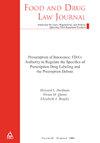生命,自由,[和幸福的追求]:历史背景下的大麻管制
IF 0.3
4区 医学
Q4 FOOD SCIENCE & TECHNOLOGY
引用次数: 0
摘要
获得医用大麻的斗争与美国历史上大多数其他争取治疗自由的斗争不同,因为大麻也有一种流行但有争议的非治疗用途——提供娱乐性快感。在将禁酒期间因医疗使用酒精而引发的斗争视为先例后,本章讲述了美国医用大麻使用和监管的历史。本章的大部分内容集中在20世纪70年代至今的医用大麻运动上。这场运动是争取治疗选择自由的法外社会运动取得成功的主要例子之一。除了1975年的一项有希望的裁决外,法院一致驳回了获得医用大麻的论点。但1996年215号提案在加利福尼亚州的通过引发了一股将医用大麻合法化的州措施浪潮,也引发了美国人对这一问题的态度的戏剧性变化。本章根据医用大麻倡导者面临的特殊法律、政治和修辞挑战,讲述了这段历史。首先,许多官员反对医用大麻合法化,无论它是否有治疗益处,因为他们认为使用大麻会危害公众健康和道德败坏。其次,根据1970年《受控物质法》,大麻被列为附表一物质,缉毒局拒绝了多名公民对其进行重新分类的请愿,这给有兴趣科学评估大麻治疗效果的研究人员设置了极大的障碍。第三,联邦政府的政策落后于公众偏好和州法律。最后,医用大麻的支持者不得不与全面大麻合法化的倡导者谈判建立一种宝贵但令人担忧的关系。这两个群体的观点和目标以令人着迷和意想不到的方式重叠和冲突。本文章由计算机程序翻译,如有差异,请以英文原文为准。
Life, Liberty, [and the Pursuit of Happiness]: Medical Marijuana Regulation in Historical Context
The struggle for access to medical marijuana differs from most other battles for therapeutic freedom in American history because marijuana also has a popular, though controversial, nontherapeutic use—delivery of a recreational high. After considering struggles over the medical use of alcohol during prohibition as a precedent, this chapter relates the history of medical marijuana use and regulation in the United States. The bulk of the chapter focuses on the medical marijuana movement from the 1970s to present. This campaign has been one of the prime examples of a successful extrajudicial social movement for freedom of therapeutic choice. With the exception of a single promising decision in 1975, courts have uniformly rejected arguments for medical marijuana access. But the 1996 passage of Proposition 215 in California triggered a tremendous wave of state measures legalizing medical cannabis, as well as a dramatic change in American attitudes about the issue.
This chapter recounts this history in light of the special legal, political, and rhetorical challenges medical cannabis advocates have faced. First, many officials have opposed the legalization of medical marijuana, regardless of whether it offers therapeutic benefits, because of the public health harms and moral degradation they associate with the use of pot. Second, marijuana’s designation as a Schedule I substance under the Controlled Substances Act of 1970, and the DEA’s rejection of multiple citizen petitions to reclassify it, has placed extremely high obstacles in the way of researchers interested in scientifically assessing marijuana’s therapeutic efficacy. Third, federal government policies have lagged behind public preference and state law. Finally, medical marijuana supporters have had to negotiate an invaluable but fraught relationship with advocates for comprehensive marijuana legalization. The perspectives and goals of these two groups have overlapped and conflicted in fascinating and unexpected ways.
求助全文
通过发布文献求助,成功后即可免费获取论文全文。
去求助
来源期刊

Food and drug law journal
医学-食品科技
CiteScore
0.20
自引率
50.00%
发文量
0
审稿时长
>36 weeks
期刊介绍:
The Food and Drug Law Journal is a peer-reviewed quarterly devoted to the analysis of legislation, regulations, court decisions, and public policies affecting industries regulated by the U.S. Food and Drug Administration (FDA) and related agencies and authorities, including the development, manufacture, marketing, and use of drugs, medical devices, biologics, food, dietary supplements, cosmetics, veterinary, tobacco, and cannabis-derived products.
Building on more than 70 years of scholarly discourse, since 2015, the Journal is published in partnership with the Georgetown University Law Center and the O’Neill Institute for National & Global Health Law.
All members can access the Journal online. Each member organization and most individual memberships (except for government, student, and Emeritus members) receive one subscription to the print Journal.
 求助内容:
求助内容: 应助结果提醒方式:
应助结果提醒方式:


